Kartografer (talk | contribs) m (fixed link) |
Kartografer (talk | contribs) (→Turn: moved section draft material here per https://www.waze.com/forum/viewtopic.php?f=1636&t=213375&start=140#p1721381) |
||
| Line 79: | Line 79: | ||
=== Turn === | === Turn === | ||
==== Streets | ==== Streets meeting at less than 46 degrees ==== | ||
[[File:Wme slight right overriden.png|left]] | [[File:Wme slight right overriden.png|left]]If drivers reaching a junction tend to slow and/or stop at an angle less than 46° to the cross road, but a turn left or right instruction is still warranted, a TIO may be used to force a turn instruction. Angles greater than 46° will issue turn instructions automatically and should not be overridden. | ||
Before Waze introduced override capability, editors forced turn instructions at such intersections by adding "dogleg" geometry nodes to ensure junction angles between 46° and 170° exclusive. When concerned about display, editors added doglegs at such fine scale as to be nearly invisible; these are called "micro-doglegs". Doglegs and micro-doglegs continue to work properly and there is no present need to replace them with overrides. | |||
Note that doglegs remain a correct and useful technique. They are completely appropriate when they reflect the typical path of drivers as they slow and stop for a turn. Even if drivers tend to approach at very sharp angles, doglegs may be used to widen the junction angle to at least 20° whether or not a TIO is used. This makes it easier for drivers to identify the turn for closure via the app, as well as for editors to select the segment when using limited mobile tools (typically to drop or raise locks by request). | |||
Other pre-override instruction-forcing methods, especially short "segment to nowhere" stubs and deliberately incorrect alternate names, are no longer appropriate. They continue to work, however, and should be updated with care. | |||
==== At-grade connector ==== | ==== At-grade connector ==== | ||
Revision as of 17:05, 20 November 2017
WME provides an ability to override the turn instructions provided during navigation so that editors can customize those instructions to better match the reality of the road.
Use a turn instruction override whenever the default Waze selected instruction is not the desired instruction for the driver. The TIO replaces the default Waze selected instruction entirely, including the TTS and instruction list.
| Don't worry about replacing existing intersection designs that currently produce the desired instruction, but using other means of doing so (such as micro-doglegs and a virtual stub segment). We can get to those as we need to. |
How to use
Creation
| Before you set a Turn Instruction Override, It is highly recommended that you consult with a State Manager or other senior editor. |
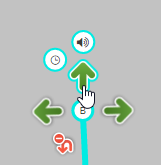
When in WME and you click on a segment and hover over a green or yellow turn connection/restriction arrow, both the Time-based Turn Restriction (TBTR) clock and the Turn instruction Override (TIO) speaker icon will appear. If the turn is red (restricted), then the override icon will not appear.
Click on the TIO icon to select an override.
Available options
When you click on the speaker, you have the following choices:

- Waze Selected (default) (this gives the default voice prompt)
- None (No instruction is given)
- Turn left (The instruction "turn left" is given)
- Turn right (The instruction "turn right" is given)
- Keep left (The instruction "keep left" is given)
- Keep right (The instruction "keep right" is given)
- Continue
- Exit left (The instruction "exit left" is given)
- Exit right (The instruction "exit right" is given)
- U-turn (The instruction "make a U-turn" is given)
When something other than "Waze Selected" is the selected option, the Instruction override speaker icon changes from ![]() (cyan) to
(cyan) to ![]() (orange). This icon is shown when you hover over a turn arrow.
(orange). This icon is shown when you hover over a turn arrow.
Identifying on the map
- The default way to determine that a turn has an override set is to hover over the turn arrow.
- Toolbox helps to make identifying turns with override instructions set.
Removal
To remove a TIO, simply set the option back to Waze Selected.
When not to use
You don't like the Waze default
Don't use a TIO to override the default just because you don't like it. We can't manage changing thousands and thousands of intersections like this.
Override is the same as Waze selected
Do not set a TIO if the override would be the same instruction as the Waze-selected one. It just adds work for fellow editors to verify.
Complex wayfinder
A complex wayfinder is one where the legs (s-out) are named differently than the subsequent segments. The wayfinder segments are named for the Big Green Sign (BGS) verbiage for clarity.
For these kinds of wayfinders, a turn instruction override alone doesn't provide sufficient clarity. Use in conjunction with a wayfinder.
Common on-ramp
An "exit" instruction for common on-ramp departures from surface streets, while not immediately intuitive for many new Wazers, is nevertheless Waze's current default. Overriding this default on a large scale could lead to problems. Meanwhile our only alternative, the "keep" instruction ("stay" in some voices), is not always significantly clearer. Except for rare cases, overriding the default "exit" instruction for on-ramps is not encouraged.
Continue TIO
Obvious continuations
Keep calm! Our Wazers have memory better than a goldfish. They don't need to be reminded to Continue straight at every intersection. Wazers are already told when or how far their next turn is after every turn.
Not impactful or unsigned name changes
Keep the turn instructions useful; don't announce simple road name changes such as when a neighborhood road changes name or if the cardinal direction changes.
Similarly, some freeways are unsigned. We do not need to place TIOs when these begin or end, as they provide no value to the Wazer.
Intermediate barrier tolls
In keeping instructions useful, it would be superfluous to inform a Wazer of each and every intermediate toll barrier in a barrier-toll system.
When to use
U-turn
This works well for one way segments that have a u-turn only lane. You can post a "u-turn" verbal prompt on the first left turn and "None" on the second one.
Turn
Streets meeting at less than 46 degrees
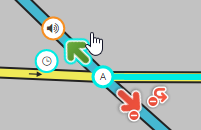
If drivers reaching a junction tend to slow and/or stop at an angle less than 46° to the cross road, but a turn left or right instruction is still warranted, a TIO may be used to force a turn instruction. Angles greater than 46° will issue turn instructions automatically and should not be overridden.
Before Waze introduced override capability, editors forced turn instructions at such intersections by adding "dogleg" geometry nodes to ensure junction angles between 46° and 170° exclusive. When concerned about display, editors added doglegs at such fine scale as to be nearly invisible; these are called "micro-doglegs". Doglegs and micro-doglegs continue to work properly and there is no present need to replace them with overrides.
Note that doglegs remain a correct and useful technique. They are completely appropriate when they reflect the typical path of drivers as they slow and stop for a turn. Even if drivers tend to approach at very sharp angles, doglegs may be used to widen the junction angle to at least 20° whether or not a TIO is used. This makes it easier for drivers to identify the turn for closure via the app, as well as for editors to select the segment when using limited mobile tools (typically to drop or raise locks by request).
Other pre-override instruction-forcing methods, especially short "segment to nowhere" stubs and deliberately incorrect alternate names, are no longer appropriate. They continue to work, however, and should be updated with care.
At-grade connector
Depending on the length and angle of an at-grade connector, it may make sense for Waze to instruct "keep right/left" or "turn right/left". Use a TIO to ensure the the most appropriate instruction is given to the driver. An example of an at-grade connector using an instruction override is shown below:
Exit/keep
Exit left
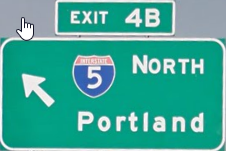
When there is a the Big Green Sign (BGS) indicating an exit left. Discuss with your Regional Coordinator(s) and/or State Manager(s) to see if they want it added to locations where a HOV or HOT/Express Lane is separated from the regular freeway, highway, etc.
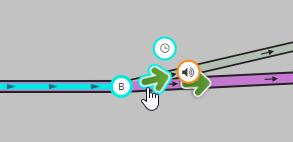
Simple wayfinder
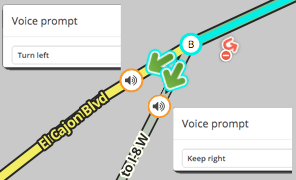
Simple wayfinders use a turn instruction override where an instruction would not normally be voiced. This is most often a "stay to the right" or "stay to the left." A basic example is a roadway with a split where left lanes turn left and right lanes go straight ahead.
To ensure the driver is kept on the correct side of the roadway to stay on the expected route, we create an instruction override to ensure the driver is given enough advance notice to make sure they are on the correct side
The image here is a composite showing both turns with the override set and which instruction has been applied in this specific case. Drivers continuing straight, the app will give the driver the instruction "stay to the right to El Cajon Blvd." For drivers getting into the on-ramp, the app will say, "turn to the left to I-8 W."
Unusual on-ramp
A default surface-road-to-on-ramp "exit" instruction may be overridden with a "keep" in rare cases when:
- the originating highway's continuation path is unclear (such situations often require wayfinders as well) or;
- the on-ramp's initial departure continues to share direction and pavement with the originating highway, either for an unexpectedly long distance, or leading to two or more subsequent distributor on-ramps that are better instructed as exits than the initial departure. The latter application avoids issuing multiple "exit" instructions for what is effectively the same on-ramp. Aside from the above situations, overriding the default "exit" instruction for surface-road-to-on-ramp departures is not encouraged (see below).
Continue
Unannounced roads with legal or financial implications
Restricted areas (border control point, military base)
When the best continuation is to a restricted area, add a Continue TIO, paired with a named stub segment if necessary, to let users know they will be now entering a restricted area.
Toll
When the best continuation is tolled, marked or unmarked (toll roads, bridges, paid entrances into large areas, etc.), add a Continue TIO, paired with a named stub segment if necessary. For barrier-toll systems, only at the beginning of the toll area.
Setting context in the instruction list
Without a Continue TIO, the next instruction could be from an entirely different road or freeway. Adding a Continue TIO would help set context as to where the instructions are and increase the Wazer's confidence in the instructions given (or not given).
Terminus of a freeway
Where a freeway ends with a best continuation onto another freeway, add a Continue TIO to indicate the name of the continuing road.
When possible, do this at a point where the user can use this TIO to make a mental confirmation.
If the continuing freeway is signed before the terminus, place the TIO at the last exit, similar to how a wayfinder is set up today.
If it isn't signed, place the TIO where the freeway merges into the next freeway.
Consult with your state manager if the freeway status changes frequently or gradually, or if the freeway itself is insignificant. There could be multiple options as to what would be the best spot for a TIO, or if one is needed at all.
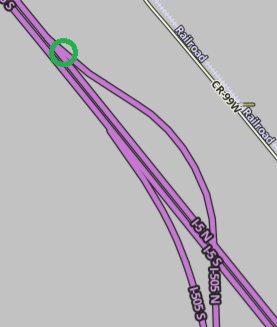
On-ramp to a freeway

When the best continuation from a road (including off-ramps, parking lot roads, and rest areas) is an on-ramp to a freeway or expressway, add a continue TIO.
Continuing from an off-ramp
Use a Continue TIO when the name of the best continuation at the end of a ramp is not immediately obvious. Here are two scenarios that it's not immediately obvious:
Supplement a wayfinder
Because controlling the turn angles in Waze will never produce a continue instruction, a Continue TIO must be set in places where a wayfinder is warranted for a particular direction, but "keep" or "exit" would be misleading.
Add a continue TIO when:
- All travel lanes are correct—telling a user to "keep" or "exit" would mean an unnecessary lane change to that side of the road out of caution; or,
- Only the center lanes are correct in a 3-way fork.
Best continuation is not the obvious continuation
Many times, when there are many turn lanes, many vehicles turning, and a plethora of signage, and straight ahead doesn't look like the right way to go, the Wazer may be hesitant that Waze is not issuing an instruction. Add a continue TIO to help assure the Wazer that continuing straight is the correct way.
Use selectively, and consult your fellow area managers for consensus.

